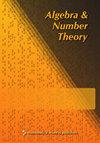Affine Deligne–Lusztig varieties with finite Coxeter parts
IF 1
1区 数学
Q2 MATHEMATICS
引用次数: 0
Abstract
We study affine Deligne–Lusztig varieties when the finite part of the element in the Iwahori–Weyl group is a partial -Coxeter element. We show that such is a cordial element and if and only if satisfies a certain Hodge–Newton indecomposability condition. Our main result is that for such and , has a simple geometric structure: the -centralizer of acts transitively on the set of irreducible components of ; and each irreducible component is an iterated fibration over a classical Deligne–Lusztig variety of Coxeter type, and the iterated fibers are either or .
具有有限 Coxeter 部分的亲和 Deligne-Lusztig 变体
我们研究了当岩崛韦尔群中元素 w 的有限部分是部分 σ-Coxeter 元素时的仿射 Deligne-Lusztig varieties Xw(b)。我们证明,当且仅当 b 满足某个霍奇-牛顿不可分性条件时,这样的 w 是一个心元,且 Xw(b)≠∅ 。我们的主要结果是,对于这样的 w 和 b,Xw(b) 有一个简单的几何结构:b 的 σ-中心化作用于 Xw(b) 的不可还原成分集;每个不可还原成分都是一个迭代纤度,迭代纤度越过 Coxeter 类型的经典 Deligne-Lusztig 变化,迭代纤度要么是 𝔸1 要么是 𝔾m。
本文章由计算机程序翻译,如有差异,请以英文原文为准。
求助全文
约1分钟内获得全文
求助全文
来源期刊

Algebra & Number Theory
MATHEMATICS-
CiteScore
1.80
自引率
7.70%
发文量
52
审稿时长
6-12 weeks
期刊介绍:
ANT’s inclusive definition of algebra and number theory allows it to print research covering a wide range of subtopics, including algebraic and arithmetic geometry. ANT publishes high-quality articles of interest to a broad readership, at a level surpassing all but the top four or five mathematics journals. It exists in both print and electronic forms.
The policies of ANT are set by the editorial board — a group of working mathematicians — rather than by a profit-oriented company, so they will remain friendly to mathematicians'' interests. In particular, they will promote broad dissemination, easy electronic access, and permissive use of content to the greatest extent compatible with survival of the journal. All electronic content becomes free and open access 5 years after publication.
 求助内容:
求助内容: 应助结果提醒方式:
应助结果提醒方式:


